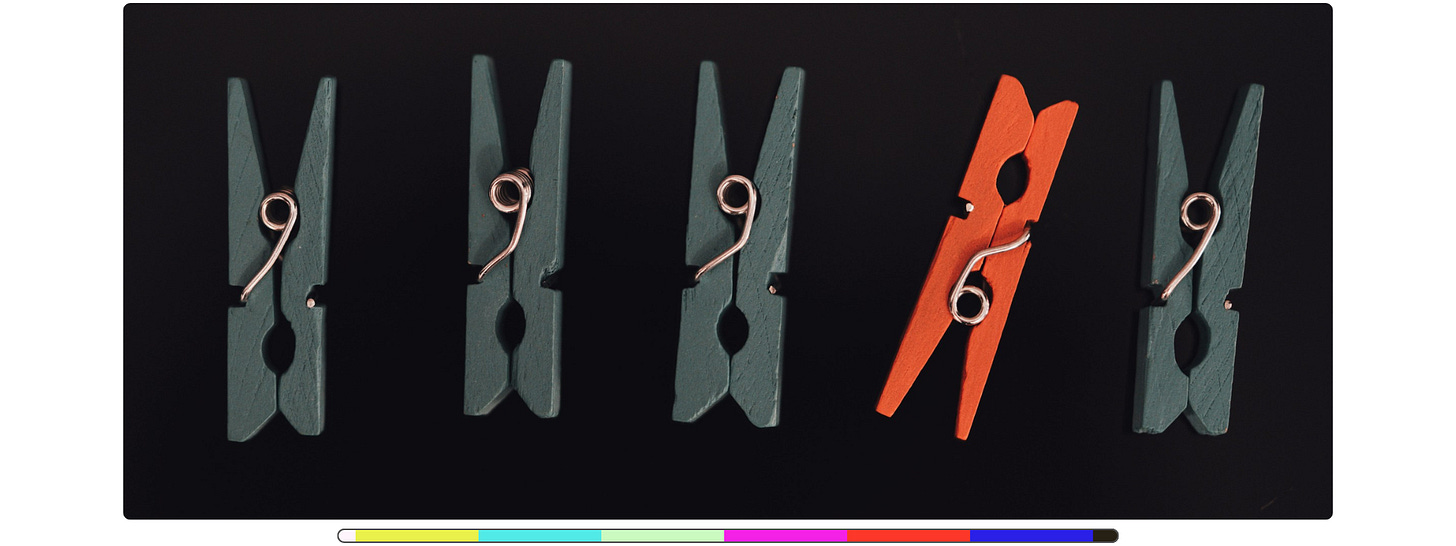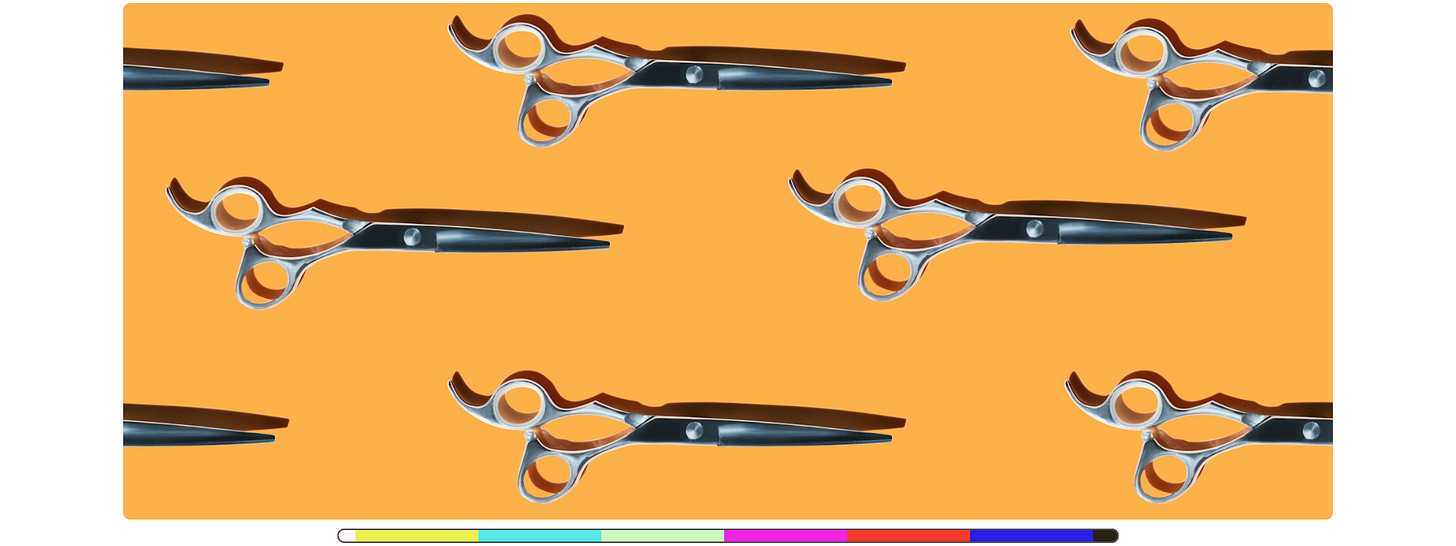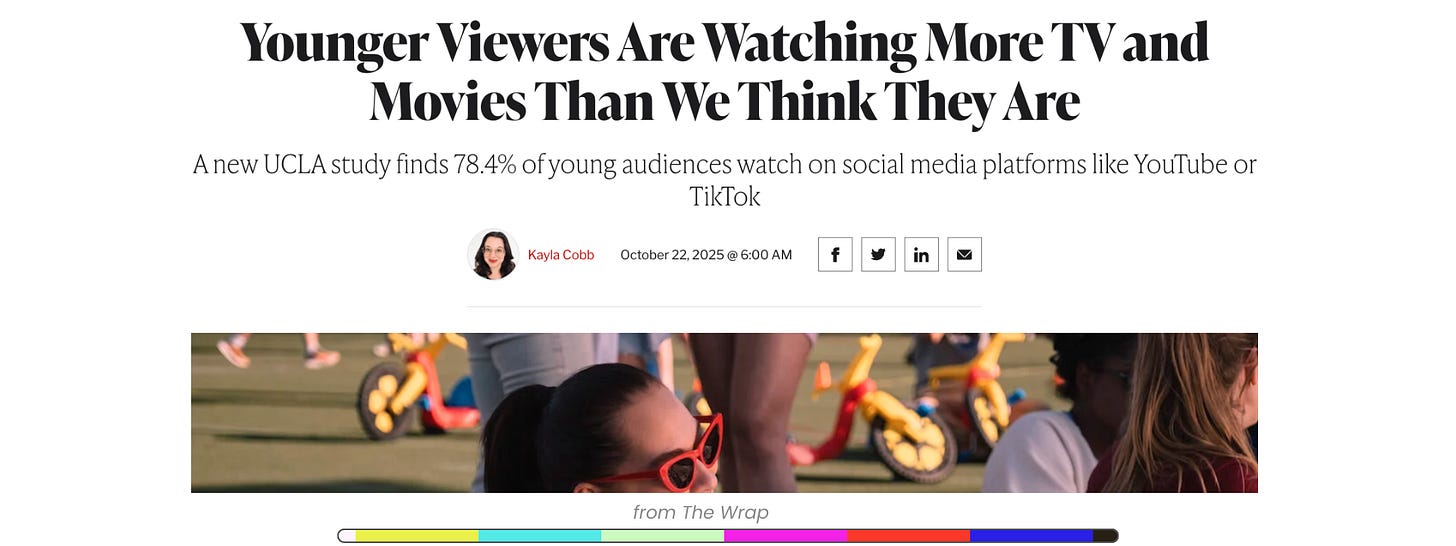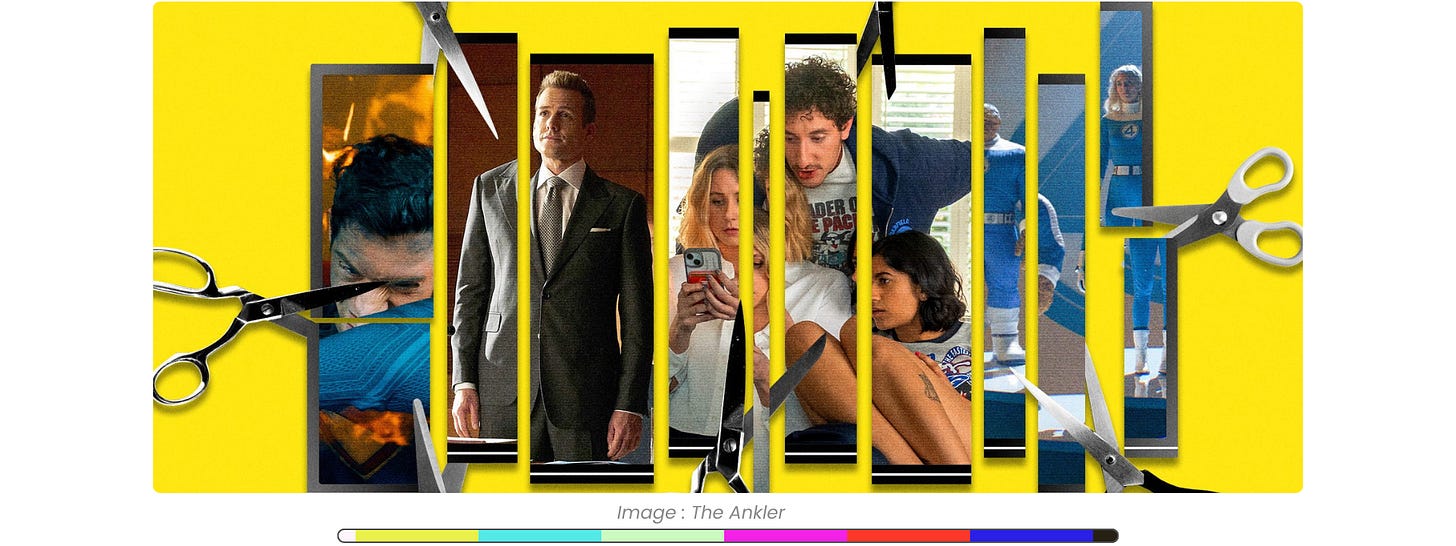Plots & Vibes
· Dance in Dakar · Clipping · ‘Plot-based media’ · Whatmore ·
Today’s dispatch threads through some fascinating ways young people are interacting with stories, and how storytelling is adapting to them. I explore how young audiences are playing with plots and vibes, a deluge of short clips shaping them.
I weave all these together with some recent reports & analysis, but also some wonderful examples of creative storytelling (and crafting vibes) with young people, from Senegal to Brooklyn.
🎧 Prefer to listen? Hit play above to listen to me read this week’s dispatch.
In the mood for plots.
A little reel from some months ago did the rounds. A comedian spoke of a conversation with her younger sister, born in 2012 - Gen Alpha, if you will. In response to a casual question about what shows were buzzing on TV, the barely-teen claimed she “didn’t watch plot-based media”.
Stories, apparently, are now a genre: ‘plot-based media.’
In a time of vibes and feels, I can see where that comes from. Scroll through Reels and Tiktoks, read Tweets and Threads. So much is just a ‘vibe’, a moment, a feel. Trending audio with a lush sunset is a mood. Guitar strumming around a bonfire is a feel. All of ASMR is a vibe. And it’s great; who doesn’t love moods? They shape, affect, inspire.
Once you see that, the concept of narrative storytelling as ‘plot-based media’, versus ‘vibe-based media’, suddenly makes sense.
“saying ‘plot based media’ as if it’s derogatory is a funny way of saying I can only watch reels and tiktoks” _IG comment
The two reflect different ways of engaging with content. Deeper investment and longer attention spans versus fast-scrolling, instant-gratification, dopamine hits. They aren’t mutually exclusive, of course. The question is whether the distraction economy we live in, and the viewing habits it shapes, is edging out the long-standing affinity for narrative storytelling.
Yet, the phrasing itself still rankles. Stories are based on plot - you might have heard of that anachronistic idea of a start, middle and end. Not everything on social media is content (or ‘media’), just by virtue of existing.
Or is it?
“Your sis acting like she’s watching experimental cinema and it’s just tiktok 😂”
_IG comment
Over at Intelligent Jello, Mike Gioia has an interesting perspective as he looked at the Sora App. In this very same dichotomy of content types, he wagers generative AI is actually best suited for vibe-based media (what he labels ‘feed media’).
“…increasingly, it feels like AI may pass over Hollywood and the traditional entertainment industrial complex. AI is useful around the edges of production, but video models are clumsy tools for long-form storytelling. AI is much better suited to (feed media).”
I don’t know. Is “plot-based media” emerging as a playful, tongue-in-cheek label that younger audiences are using? Are people actively distinguishing between traditional, long-form narratives and quick, vibe-driven content through this lens? Is it representative of very young people having been raised on a diet of short bursts of ‘content’? Or am I attributing too much to a stray comment?
What’s your vibe?
“so gen alpha has literally lost the plot? 😂” _IG comment
The plot thickens
Watching movies and TV after all?
There is generally plenty of doom & gloom around how young people are not watching ‘traditional‘ media. Or, barely any narrative content at all, if you go by the plot vs vibe view! Much has been written about YouTube’s dominance of eyeballs and, we are constantly persuaded, culture itself. The latest in this screamed, “YouTube Just Ate TV. It’s Only Getting Started”.
But a new study from UCLA’s Center for Scholars & Storytellers suggests younger viewers are watching more TV and movies than we might think. In a US-only survey, 57% of the 1,500 participants ranging from 10-24 years, said they are watching traditional media more than older generations assume. Also, 53% discuss movies & TV shows with friends more than they discuss social media content.
The question has to be asked, though- are TV and movies the same without TV screens and cinema halls? “Over three-fourths of participants said they sometimes watch TV and movies on social media platforms like YouTube or TikTok, and nearly half said they mostly watch TV and movies on a personal device like a phone or computer, rather than a TV”
Maybe, the medium has changed much more than the appetite?
Glimpsing the plot.
So much of our content discovery is via social media. Finding, enjoying (and scrolling past) short reels from series, podcasts, sitcoms and even sports. This is even truer when chasing younger audiences.
Posting podcast video clips is almost its own ecosystem (though impact on actual listenership and audience growth is questionable). It’s much the same with clips from premium shows, comedies, stand-up. These are not traditional promo spots, just little bits & bobs enjoyable on their own. Sometimes, they are meant to build awareness of a show, seeded by the producers or networks. Other times, it’s just ‘resourceful’ creators leveraging easily available IP for views & likes.
Clipping
“We basically put the whole season one in a Google Drive folder and gave it to these editors and clippers to kind of go ham.”
That refers to FX’s show Adults, for which companies like Clip hire teenage ‘clippers’ who reportedly earn ~$1 per 1,000 views generated.
This business of ‘clipping’ is fast becoming a lucrative one- but it almost purely rewards only virality, since that’s how clippers are paid. Creators are looking at a barrage to build momentum around their content. It’s gaming the game, and those in the wider media world should hardly be surprised.
It might well come as an awkward surprise to most viewers of such clips, though. Social media feeds these via an opaque algorithm in the name of personalised entertainment. Scrollers might be dismayed to know it’s often just the result of a commercially-driven flood.
As an aside- “ ’building a narrative’ is what separates the best clippers from the rest.” This gem, from someone who runs a clipping team, is an example of how terms like narrative and storytelling are tossed around so freely.
The 23-year-old founder of Clipping is on point, “People used to buy commercials on TV, billboards, radio time slots. Clipping is that for the modern era. It’s buying space and time on people’s phones while they scroll.”
For creators, this is fast becoming an integral part of the ecosystem. The view is less clear-cut for IP owners of traditional media like movies or TV shows.
Nibble or eat?
The most common question here is whether clips serve actual viewership off-platform, or end up cannibalising the film or show’s performance. In essence, do the clips become “enough” for viewers, who aren’t motivated enough to seek those films or shows out? That’s the tricky part. By all accounts, one where the jury continues to be very much out. There’s just not enough data, and most IP holders still hesitate to go all-in with clips precisely because of this concern.
But, we do have a good example with late-night and talk shows. For some time now, the linear episodes have had declining viewership in the US (and significantly low viewership elsewhere). This, even though the hosts and their pieces are clearly popular across the globe- take a look at their Youtube viewership.
Aggressively publishing highlight clips has undoubtedly been a great way to keep the performers alive in the cultural zeitgeist. But over time, it’s also effectively taught us all that you no longer have to actively seek out the shows to get their best moments.

With podcasts, there’s an added layer. The allure of high-engagement social clips could turn long and rich podcast episodes into mere clip factories. Again, what’s unclear is how sustainable that is, given most podcasts are making their money off ads on the main show, not social clips.
Clipping’s impact in building fandoms, marketing film and TV — and, on the other hand, possibly devaluing IP by chopping it up into sticky, viral bits that could undermine the whole — is immeasurable.
The temptation is obvious; the reward, less so.
There have been a few reports on this in recent weeks.
The Ankler article ($) from Matthew Frank used ‘Adults’ as a study to dive into the operational world of clipping shows and Max Peterson’s company Clip, run largely on Discord.
On WSJ ($) Ben Raab explores this from different angles.
Just yesterday, Bloomberg’s Cecilia D’Anastasio looked at it ($) by profiling 23-year-old Anthony Fujiwara, founder of Clipping, who has a wide base of clients including Mr Beast.
Mr Beast, though, has partnered for a clipping service himself. Vyro connects editors with creators to fill precisely this need, presumably scaling up from some of these that run on a Discord server.
Ashley Carman asked this question about podcasts, too.

A soft landing, after all that?
🎬 Curated/Cuts.
1. Whatmore: the bar
Music artists have been getting pretty inventive around how they promote new albums.
NYC band Whatmore’s videos about their debut album (which dropped a couple of weeks ago) struck me because it puts a pin on some of those cliches we hear about media & creativity in this age.
Authenticity, not posturing. Relatability, not untouchability. Vulnerability, not rockstar bravado. All executed, published and shared in ways which really weren’t doable just some years ago.
@jackson.august_ · filmed by patrick linehan ·
2. Wales Bonner in Senegal
British designer Grace Wales Bonner was just announced to lead menswear at Hermes. But she earned her creds with her own label, which she started in 2014.
The Dance of the Sea is a languid exercise in the choreographed ebbs & flows of youth by the Senegalese shores of the Atlantic. I had lined up this short film for her label Wales Bonner, which released in the summer, presented by nowness.
“In Dakar, the dance of the sea is not just a visual spectacle but a song to unity. Every wave that rises is an invitation to embrace community, and to understand that, like the ocean, we are part of something much greater. This journey reminds us that no matter how far we go, there will always be a dance that connects us, a rhythm that makes us more human.”
Directed by jorge perez ortiz & rodri porcelli · Music: Raúl Espiñeira · Produced by @lockstudios










